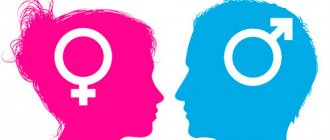Sociologists use two different terms to refer to biological and socially constructed differences: sex and gender. Although both are concerned with the differences between men and women, the concepts of sex and gender have different connotations. Sex refers to differences in both the biological, anatomical, physiological, and chromosomal characteristics of people that define them as male or female.
They are characteristics that a person is born with, and they are universal, that is, they are common to all societies and cultures, and they do not change.
Gender is a set of ideas, beliefs and social identities that are constructed in every culture and at every historical moment on the basis of sexual differences. And its features have been formed throughout the history of social relations.
Gender - what is it
The gender approach or perspective looks at the different opportunities that men and women have, the relationship between them, and the different roles they are assigned in society. Gender relations shape different ways of accessing health services, especially in the area of sexual and reproductive health.
In anthropology, gender is defined as the cultural and historical interpretation that each society develops around sexual differentiation. This interpretation gives rise to a set of social beliefs, practices, discourses, norms, values and attitudes that give meaning to people's behavior based on their gender.
In psychology, gender is defined as the process by which biologically different people become women and men through the acquisition of attributes that each society defines as characteristics of femininity and masculinity. In this sense, gender is a psychosocial construction of femininity and masculinity.
What are gender differences from a psychological point of view? These are categories in which three main elements are formulated:
Gender, on the other hand, has been conceptualized as the structuring element of a set of social relations—gender relations—that shape the interactions of people as sexual partners. Gender relations are socially constructed and therefore amenable to transformation. They do not come from biology and are not necessarily harmonious; on the contrary, they can contradict each other.
Gender role
Gender roles are behaviors that are socially perceived as appropriate for each gender.
Gender roles in society determine how we should act, speak, dress, court others or partners, and behave based on our gender. For example, women and girls are expected to dress femininely, be polite, gracious, and have maternal tendencies. In turn, men are expected to be strong, aggressive and fearless.
In both cases it is a social construct, rules set by the context in which each person lives. Thus, behavior that is considered appropriate for the female gender may vary from one culture to another and from one time to another. This is because every society, ethnic group and culture has expectations regarding gender roles.
In turn, gender roles are constantly changing and evolving in tandem with other social norms. Thus, 70 years ago in Europe it was reprehensible for women to wear trousers or it was surprising for a man to devote himself to housework. Today, both behaviors are normalized as society has made progress in terms of gender equality.
Gender identity
Gender identity is how we feel about ourselves and how we express those feelings. Clothing, appearance and behavior are ways of expressing gender identity.
Most people feel like men or women. Some people feel like masculine women or feminine men. These people may consider themselves gender variant. And some people feel like they are neither male nor female—these people may consider themselves “cross-gender” or “gender fluid.” The idea of one’s own gender identity begins to take shape at 2–3 years of age.
For some people, sex and gender identity are the same or related. These people are called "cisgender". Other people believe that their assigned gender is different from their identity gender (for example, their assigned gender is female, but their gender identity is male). These people are called "transgender" or "tranny". But not all transgender people have the same identity.
History of the concept
As a category of analysis, the concept of "gender" was first used in the social sciences in 1955, when anthropologist John Money coined the terms "gender role" and "gender identity" to describe the behaviors socially attributed to men and women.
In 1968, psychologist Robert Stoller defined this “gender identity,” which is determined not by biological sex, but by the fact that from birth one has acquired the experiences, rites and customs, and patterns of behavior attributed to each gender.
In the 70s, Anglo-Saxon feminism promoted the use of this concept to highlight inequalities between men and women that are socially constructed rather than biological.
Therefore, the distinction between sexual differentiation as determined by the chromosomal, gonadal, hormonal, anatomical and physiological sex of individuals and the interpretations each society makes of this allows for a better understanding of social reality. It also shows that human characteristics considered feminine or masculine are acquired through a complex individual and social process.
In the 1980s, the term "gender" began to be used in various social science disciplines because it proved to be a useful category for making a more precise distinction: how difference (biological) becomes inequality (economic, social and political) between women and men, placing the determinants of inequality genders on a symbolic, cultural and historical basis.
Communication differences2
Women tend to speak in the 1st person, they do not often interrupt a person, their speech is more correct, competent, they are less likely to laugh them off and call them names, and do not use slang. But women love unfinished sentences with subtext. Girls are well versed in colors and shades and often use adjectives.
Men are characterized by persistent, demanding, aggressive speech. They understand technical concepts better. And they are prone to using various specific words and harsh obscene statements, but women have recently been overcoming this gender difference, as proven by science.
Gender roles and gender stereotypes
More and more changes are taking place in society and culture. This means that what is considered masculine and feminine is also changing. Today, in all societies, we see that women are no longer confined to the home, but rather enter the public space, have high-paying jobs and participate in productive tasks.
And men are involved in reproductive tasks and take on responsibilities at home and caring for children, elderly and sick relatives. Men change and participate in household chores and concerns.
This situation is positive because it leads to gender equality. According to the UN, it is believed that if all men participated in caring for the sick, there would be fewer wars.
Nonverbal Communication 3
Researchers have found that girls smile more often when talking, and they look longer into the eyes of the narrator than when speaking. Guys behave the same way when they listen and speak. They have developed tactile contact, they want to touch their interlocutor, especially pretty girls.
Classification of genders, distinctive features
Diversity is present in all aspects of life, it is a generator of agreements and disagreements, as it represents one of the main current conflicts in our society. Any type of diversity: ethnic, cultural or gender implies values such as solidarity and respect for differences. A person should live their sexual orientation and gender identity freely and responsibly.
Currently, there are three main types of gender identity:
Bipolar
Initially, bipolar identity assumed a strict differentiation of gender identity based on sex (men have exclusively masculine characteristics, and women have feminine ones).
At the end of the twentieth century, the concept of a bipolar model of gender identity was revised. At the moment, it is assumed that men and women do not necessarily conform to traditional sex role models and can combine the characteristics of both sexes in their behavior.
Multipolar
The multipolar model of gender identity allows for the existence of several options for gender identity within the same sex.
The multipolar model of gender identity is represented by 6 options:
Androgynous
Gender ambiguity is also known as androgyny.
The word "androgyny" comes from the Greek word "andro" and means man - masculinity, and the word "gyne" means woman - femininity.
Thus, androgyny, having a non-binary gender identity, means having both masculine and feminine characteristics. According to scientists, the androgyne has fulfilled the highest dream of every person: to have both sexes at the same time.
Due to the fact that androgyny refers to people who do not want to be seen/identified by their gender - they can have absolutely any appearance and sexual orientation.
By object of attraction
Describing a person's enduring physical, romantic, and/or emotional attraction to another person, that gender identity and sexual orientation are not the same thing. Non-binary genders can be straight, lesbian, gay, bisexual or queer. For example, a person who is transitioning from male to female and who is attracted exclusively to men will usually identify as a heterosexual woman.
Research by American scientists i
Reis and his assistants analyzed 122 different physical and personality traits in more than 13 thousand subjects. The results were reported in the February issue of the journal Personality and Social Psychology.
Physical characteristics examined included height, weight, shoulder width, arm circumference, and waist-to-hip ratio. As for psychological qualities, scientists have studied parameters such as empathy, desire or fear of success, preferences in love, sexual behavior, and so on.
Current use of the term
National governments and public organizations have been using the term “gender” extensively for a long time. They are developing a range of policies, tools and resources to ensure that their development programs take into account gender inequalities.
These strategies include mainstreaming a gender perspective into the organization, conducting gender and sexuality analyzes and gender assessments to determine the impact of programs, policies and laws.
Progress in implementing these strategies, and therefore in increasing gender awareness and gender equality, has been slow. Reasons for this include lack of commitment from stakeholders and insufficient allocation of resources.
Gaps in the collection, processing and reporting of gender-sensitive data also pose a major challenge to effective gender analysis.
Although gender issues are often recognized as important and clearly distinguished from sex issues, states and public organizations often pay less attention to them, considering other aspects of development, such as democracy, poverty or conflict, to be more relevant.
Natalia Shakhova











